FORD E-450 2004 Owners Manual
Manufacturer: FORD, Model Year: 2004, Model line: E-450, Model: FORD E-450 2004Pages: 240, PDF Size: 3.8 MB
Page 101 of 240
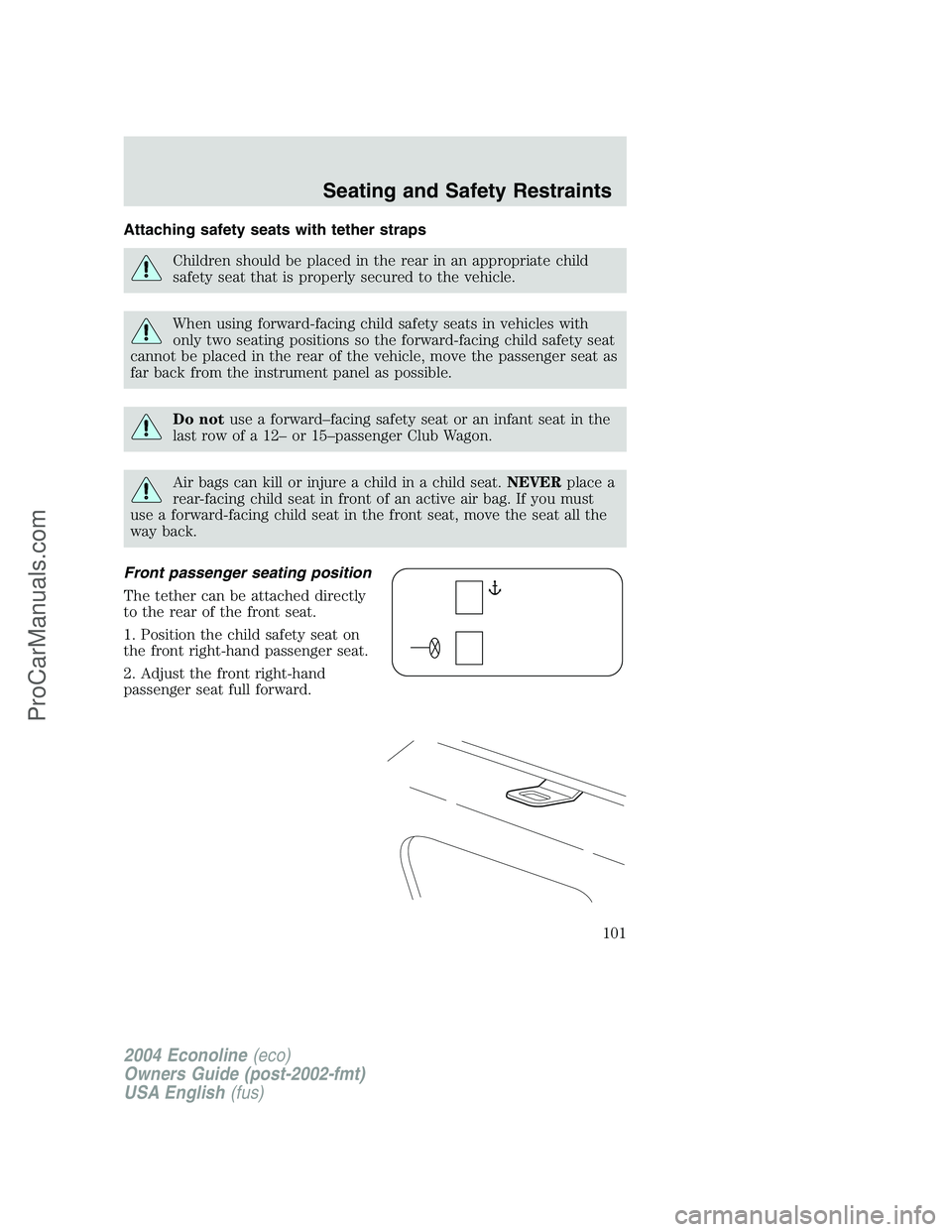
Attaching safety seats with tether straps
Children should be placed in the rear in an appropriate child
safety seat that is properly secured to the vehicle.
When using forward-facing child safety seats in vehicles with
only two seating positions so the forward-facing child safety seat
cannot be placed in the rear of the vehicle, move the passenger seat as
far back from the instrument panel as possible.
Do notuse a forward–facing safety seat or an infant seat in the
last row of a 12–or 15–passenger Club Wagon.
Air bags can kill or injure a child in a child seat.NEVERplace a
rear-facing child seat in front of an active air bag. If you must
use a forward-facing child seat in the front seat, move the seat all the
way back.
Front passenger seating position
The tether can be attached directly
to the rear of the front seat.
1. Position the child safety seat on
the front right-hand passenger seat.
2. Adjust the front right-hand
passenger seat full forward.
2004 Econoline(eco)
Owners Guide (post-2002-fmt)
USA English(fus)
Seating and Safety Restraints
101
ProCarManuals.com
Page 102 of 240
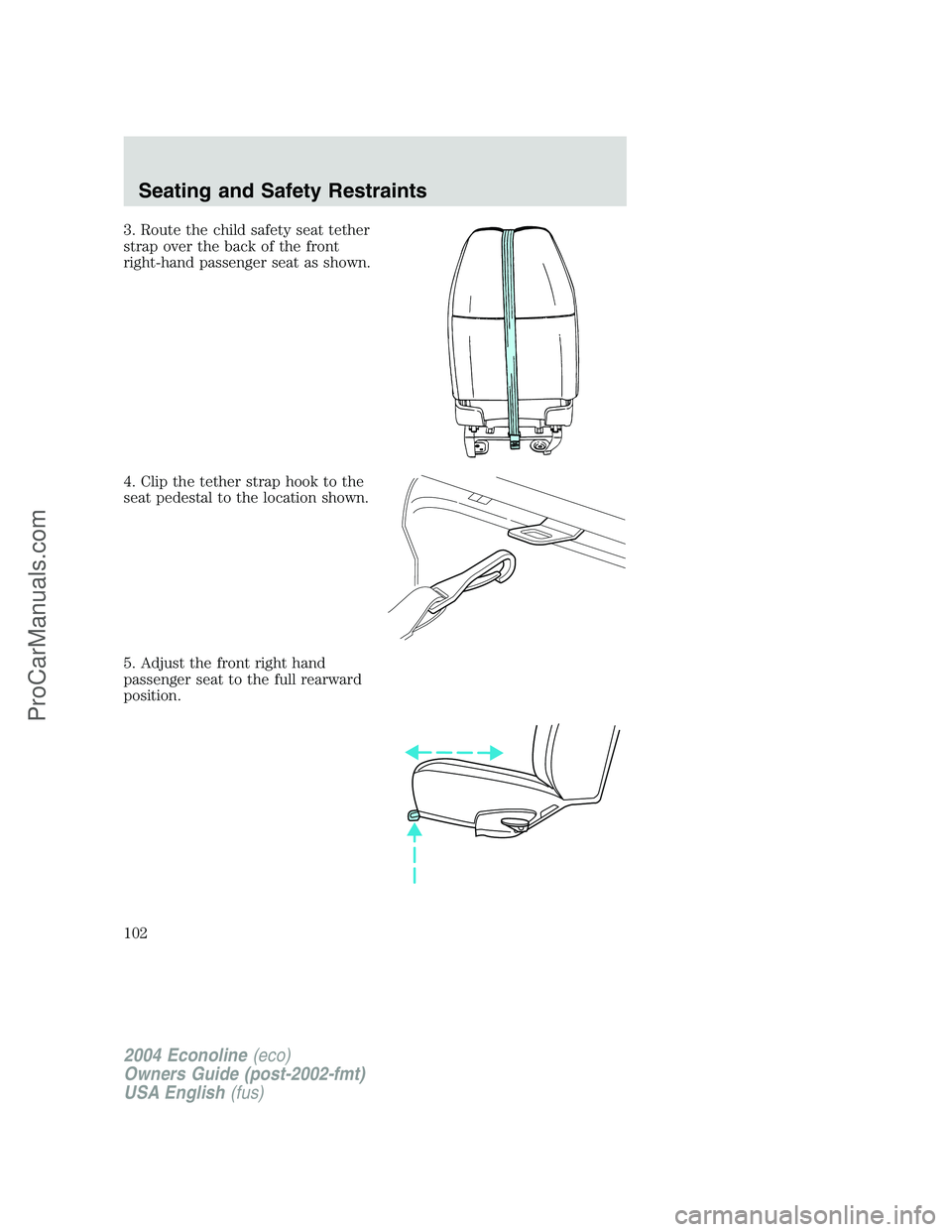
3. Route the child safety seat tether
strap over the back of the front
right-hand passenger seat as shown.
4. Clip the tether strap hook to the
seat pedestal to the location shown.
5. Adjust the front right hand
passenger seat to the full rearward
position.
2004 Econoline(eco)
Owners Guide (post-2002-fmt)
USA English(fus)
Seating and Safety Restraints
102
ProCarManuals.com
Page 103 of 240
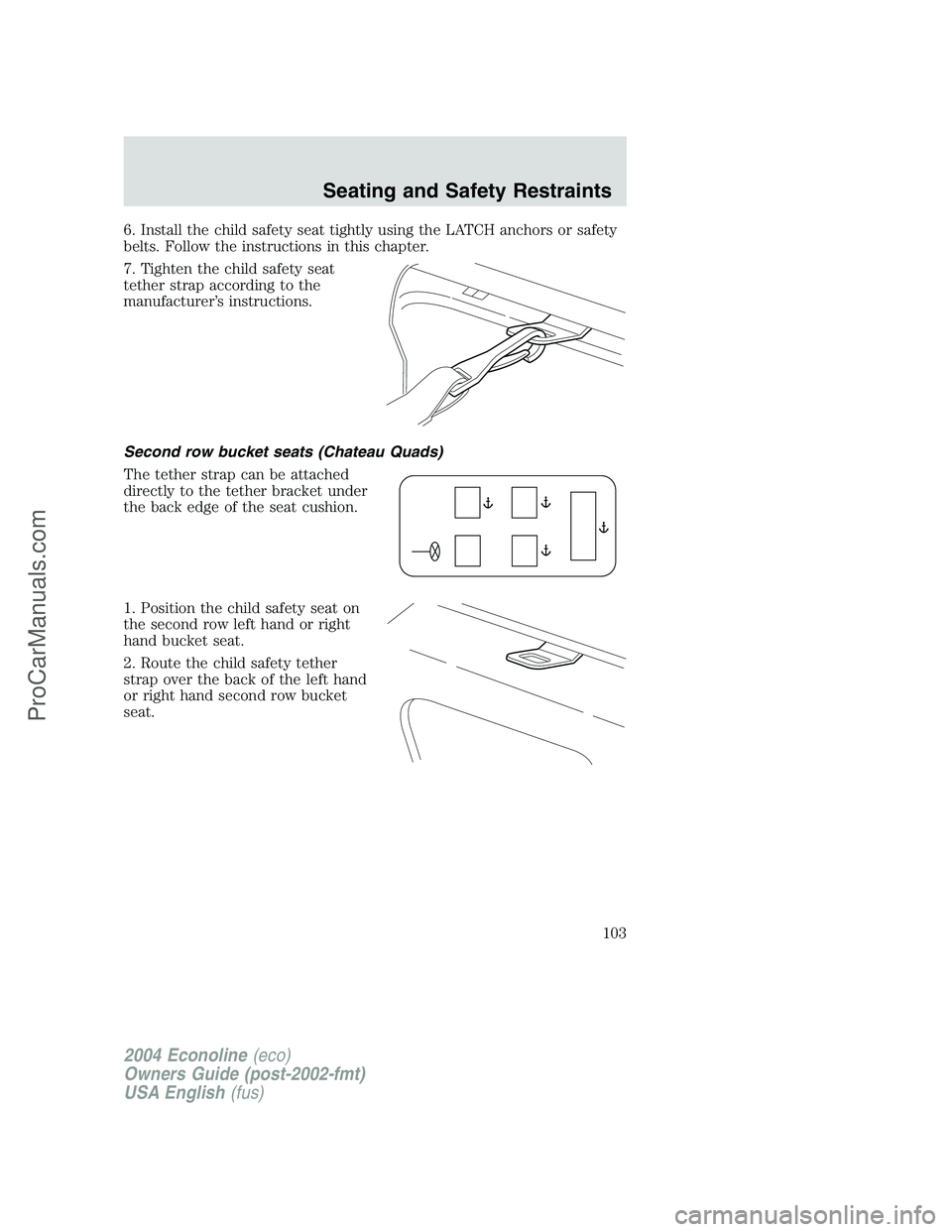
6. Install the child safety seat tightly using the LATCH anchors or safety
belts. Follow the instructions in this chapter.
7. Tighten the child safety seat
tether strap according to the
manufacturer’s instructions.
Second row bucket seats (Chateau Quads)
The tether strap can be attached
directly to the tether bracket under
the back edge of the seat cushion.
1. Position the child safety seat on
the second row left hand or right
hand bucket seat.
2. Route the child safety tether
strap over the back of the left hand
or right hand second row bucket
seat.
2004 Econoline(eco)
Owners Guide (post-2002-fmt)
USA English(fus)
Seating and Safety Restraints
103
ProCarManuals.com
Page 104 of 240
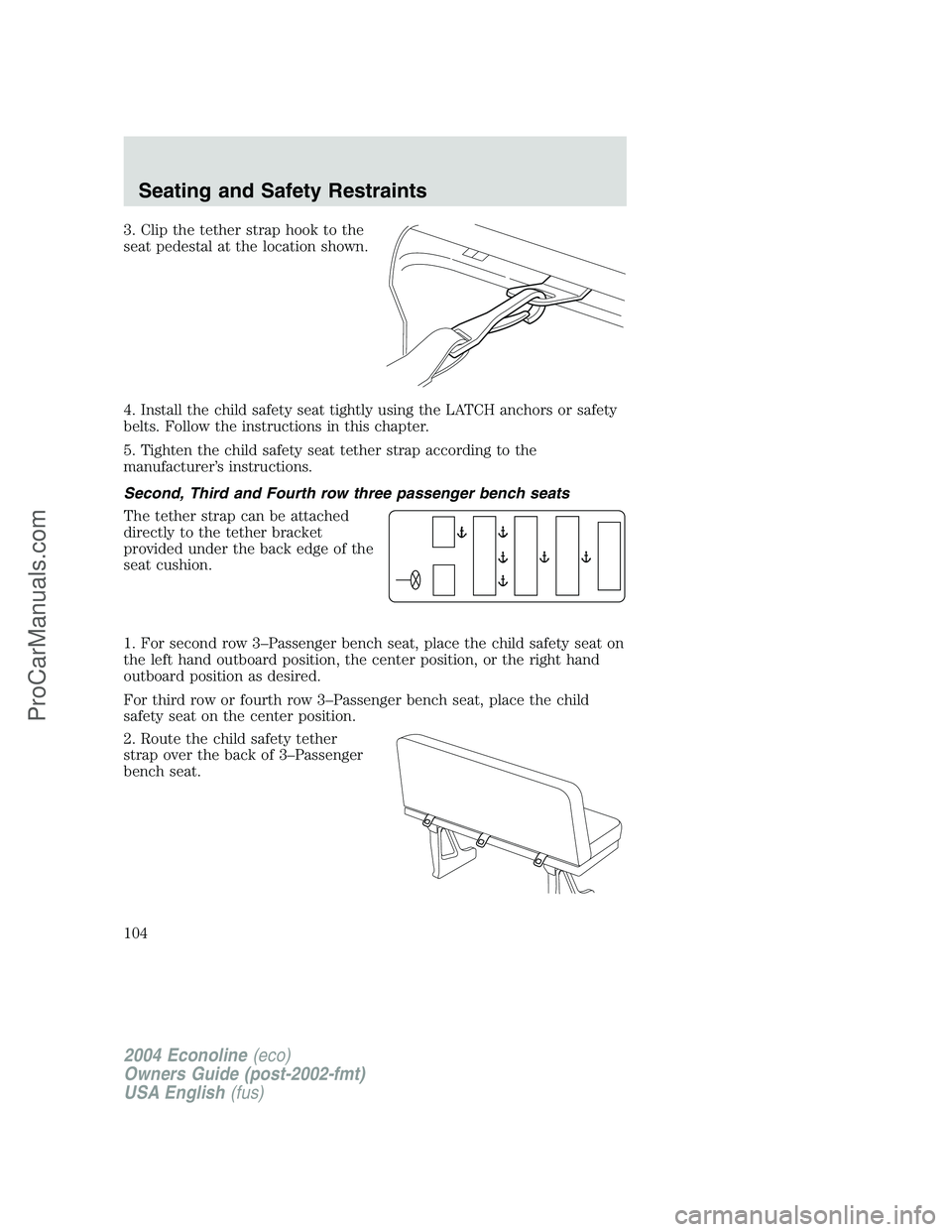
3. Clip the tether strap hook to the
seat pedestal at the location shown.
4. Install the child safety seat tightly using the LATCH anchors or safety
belts. Follow the instructions in this chapter.
5. Tighten the child safety seat tether strap according to the
manufacturer’s instructions.
Second, Third and Fourth row three passenger bench seats
The tether strap can be attached
directly to the tether bracket
provided under the back edge of the
seat cushion.
1. For second row 3–Passenger bench seat, place the child safety seat on
the left hand outboard position, the center position, or the right hand
outboard position as desired.
For third row or fourth row 3–Passenger bench seat, place the child
safety seat on the center position.
2. Route the child safety tether
strap over the back of 3–Passenger
bench seat.
2004 Econoline(eco)
Owners Guide (post-2002-fmt)
USA English(fus)
Seating and Safety Restraints
104
ProCarManuals.com
Page 105 of 240
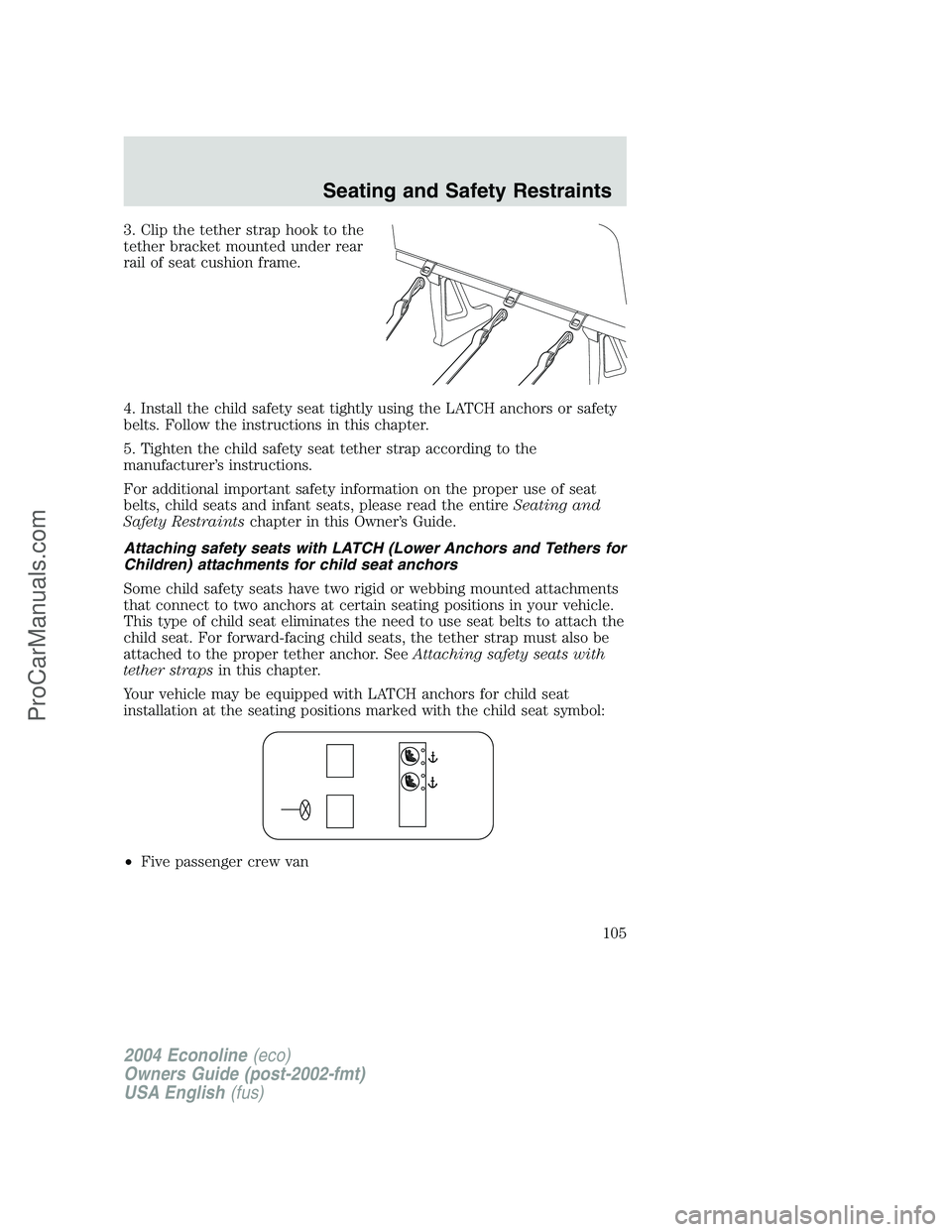
3. Clip the tether strap hook to the
tether bracket mounted under rear
rail of seat cushion frame.
4. Install the child safety seat tightly using the LATCH anchors or safety
belts. Follow the instructions in this chapter.
5. Tighten the child safety seat tether strap according to the
manufacturer’s instructions.
For additional important safety information on the proper use of seat
belts, child seats and infant seats, please read the entireSeating and
Safety Restraintschapter in this Owner’s Guide.
Attaching safety seats with LATCH (Lower Anchors and Tethers for
Children) attachments for child seat anchors
Some child safety seats have two rigid or webbing mounted attachments
that connect to two anchors at certain seating positions in your vehicle.
This type of child seat eliminates the need to use seat belts to attach the
child seat. For forward-facing child seats, the tether strap must also be
attached to the proper tether anchor. SeeAttaching safety seats with
tether strapsin this chapter.
Your vehicle may be equipped with LATCH anchors for child seat
installation at the seating positions marked with the child seat symbol:
•Five passenger crew van
2004 Econoline(eco)
Owners Guide (post-2002-fmt)
USA English(fus)
Seating and Safety Restraints
105
ProCarManuals.com
Page 106 of 240
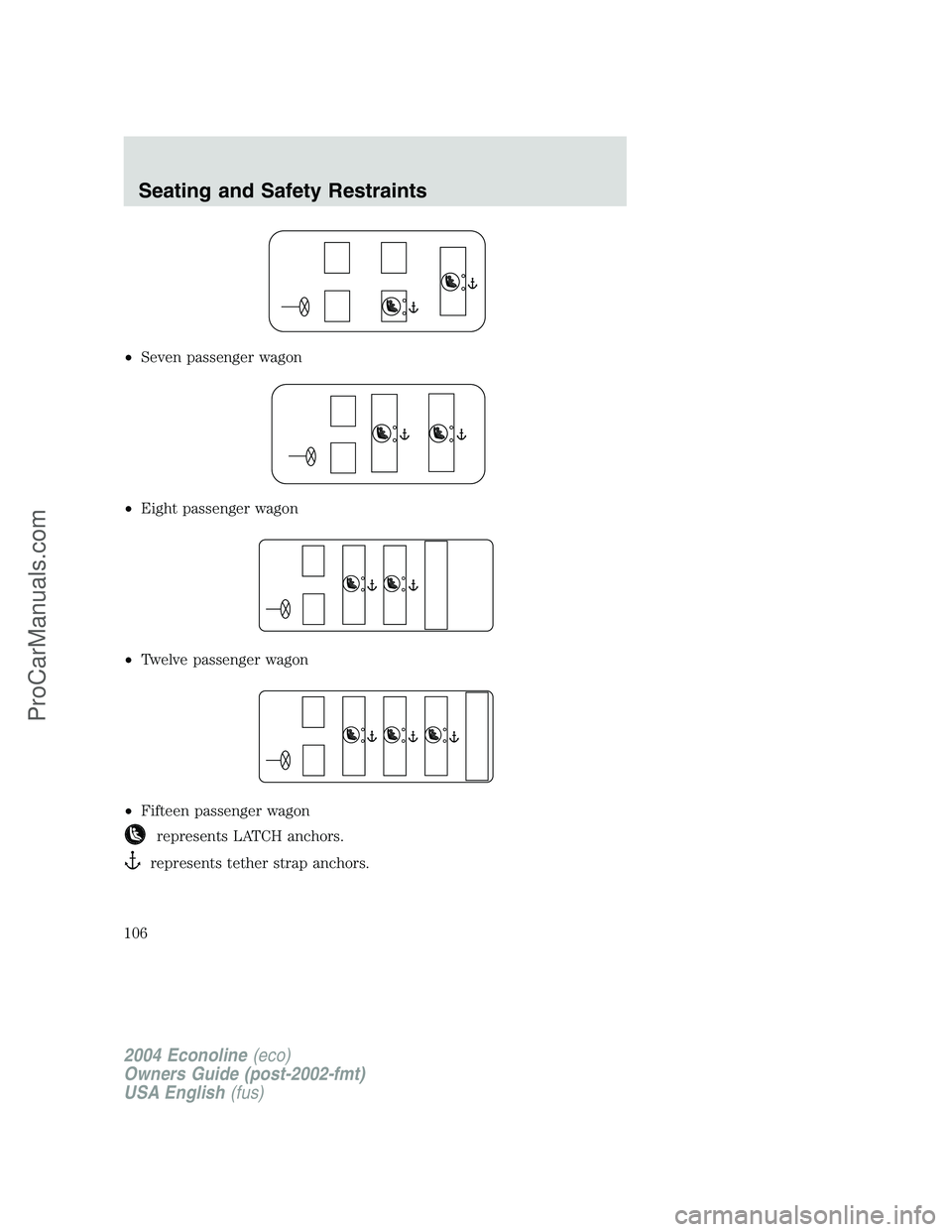
•Seven passenger wagon
•Eight passenger wagon
•Twelve passenger wagon
•Fifteen passenger wagon
represents LATCH anchors.
represents tether strap anchors.
2004 Econoline(eco)
Owners Guide (post-2002-fmt)
USA English(fus)
Seating and Safety Restraints
106
ProCarManuals.com
Page 107 of 240
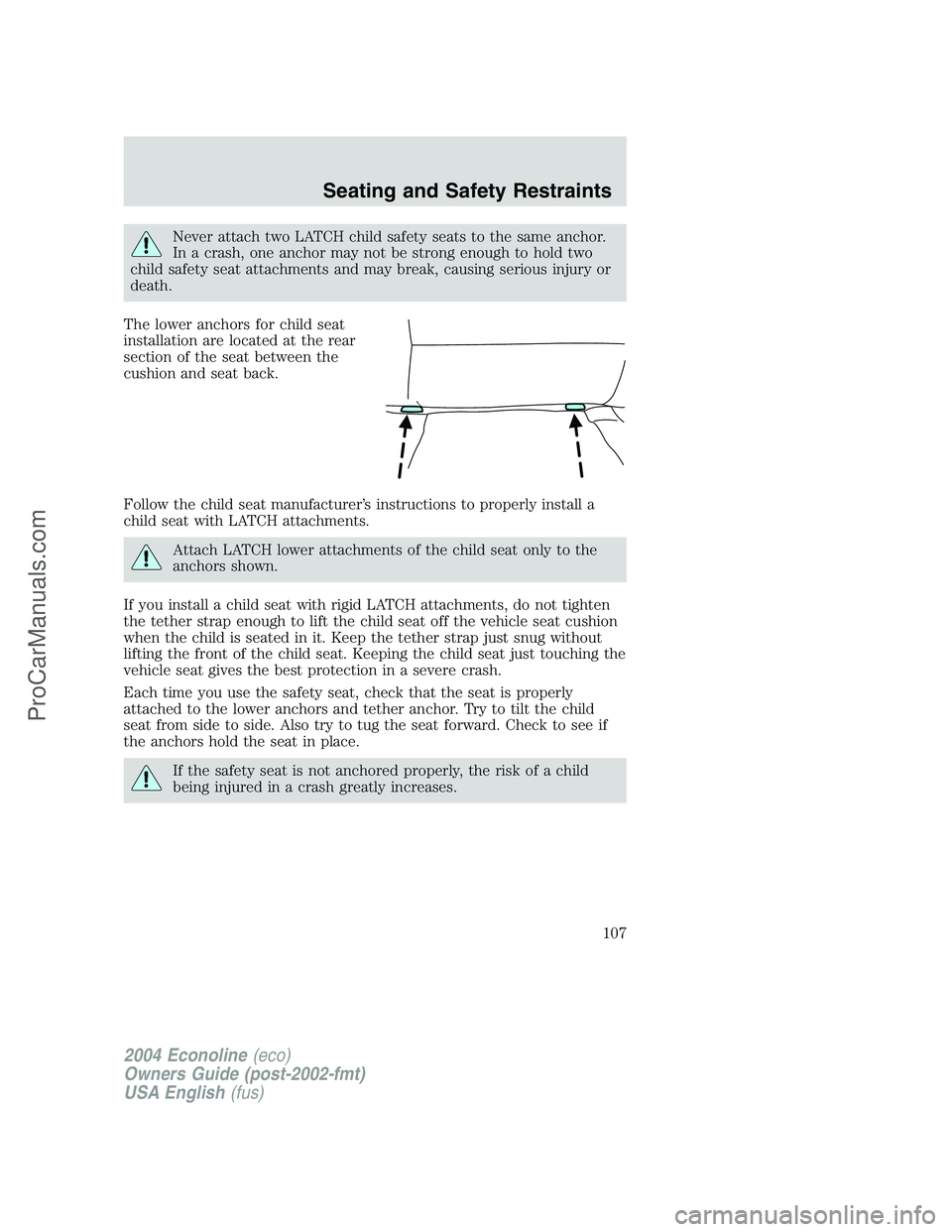
Never attach two LATCH child safety seats to the same anchor.
In a crash, one anchor may not be strong enough to hold two
child safety seat attachments and may break, causing serious injury or
death.
The lower anchors for child seat
installation are located at the rear
section of the seat between the
cushion and seat back.
Follow the child seat manufacturer’s instructions to properly install a
child seat with LATCH attachments.
Attach LATCH lower attachments of the child seat only to the
anchors shown.
If you install a child seat with rigid LATCH attachments, do not tighten
the tether strap enough to lift the child seat off the vehicle seat cushion
when the child is seated in it. Keep the tether strap just snug without
lifting the front of the child seat. Keeping the child seat just touching the
vehicle seat gives the best protection in a severe crash.
Each time you use the safety seat, check that the seat is properly
attached to the lower anchors and tether anchor. Try to tilt the child
seat from side to side. Also try to tug the seat forward. Check to see if
the anchors hold the seat in place.
If the safety seat is not anchored properly, the risk of a child
being injured in a crash greatly increases.
2004 Econoline(eco)
Owners Guide (post-2002-fmt)
USA English(fus)
Seating and Safety Restraints
107
ProCarManuals.com
Page 108 of 240
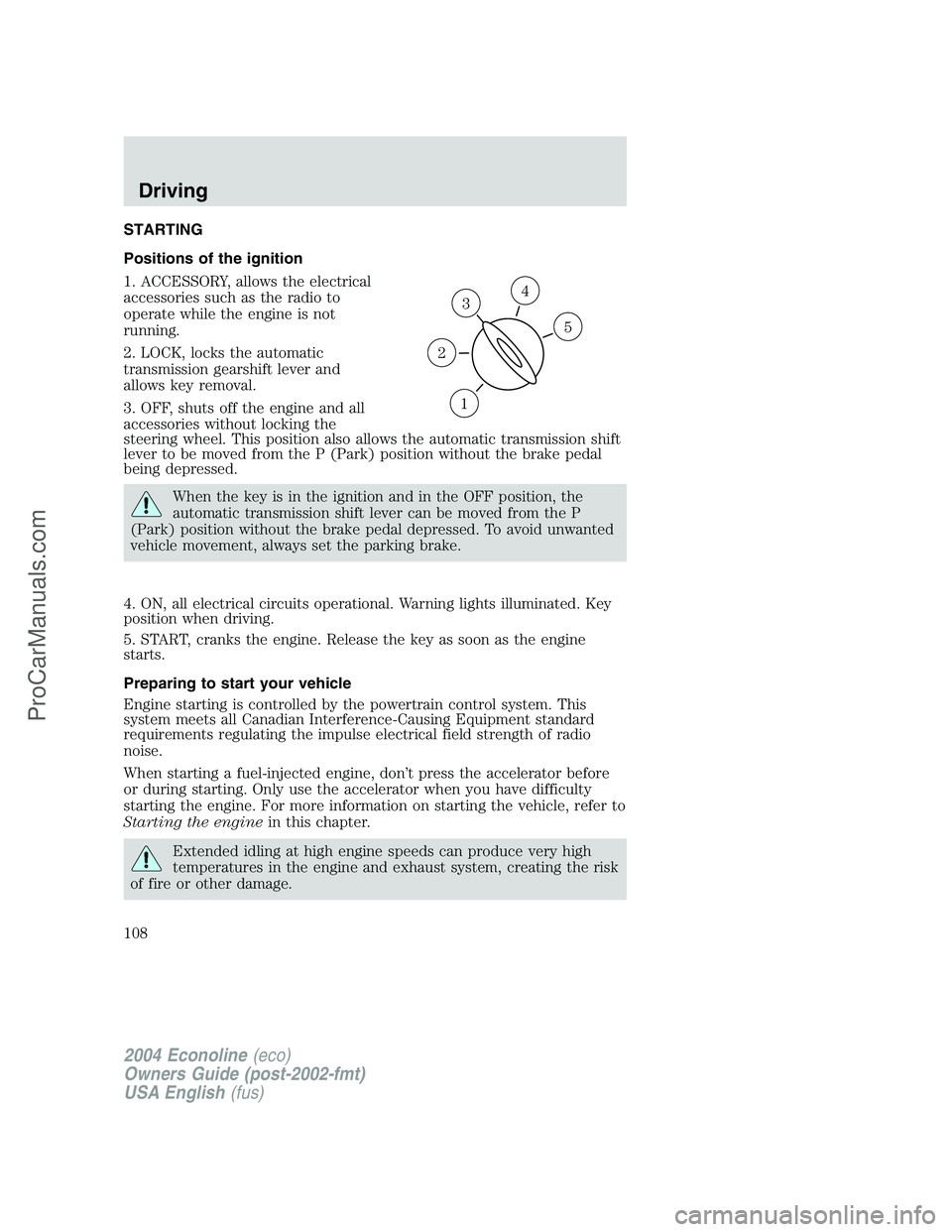
STARTING
Positions of the ignition
1. ACCESSORY, allows the electrical
accessories such as the radio to
operate while the engine is not
running.
2. LOCK, locks the automatic
transmission gearshift lever and
allows key removal.
3. OFF, shuts off the engine and all
accessories without locking the
steering wheel. This position also allows the automatic transmission shift
lever to be moved from the P (Park) position without the brake pedal
being depressed.
When the key is in the ignition and in the OFF position, the
automatic transmission shift lever can be moved from the P
(Park) position without the brake pedal depressed. To avoid unwanted
vehicle movement, always set the parking brake.
4. ON, all electrical circuits operational. Warning lights illuminated. Key
position when driving.
5. START, cranks the engine. Release the key as soon as the engine
starts.
Preparing to start your vehicle
Engine starting is controlled by the powertrain control system. This
system meets all Canadian Interference-Causing Equipment standard
requirements regulating the impulse electrical field strength of radio
noise.
When starting a fuel-injected engine, don’t press the accelerator before
or during starting. Only use the accelerator when you have difficulty
starting the engine. For more information on starting the vehicle, refer to
Starting the enginein this chapter.
Extended idling at high engine speeds can produce very high
temperatures in the engine and exhaust system, creating the risk
of fire or other damage.
3
1
2
5
4
2004 Econoline(eco)
Owners Guide (post-2002-fmt)
USA English(fus)
Driving
108
ProCarManuals.com
Page 109 of 240
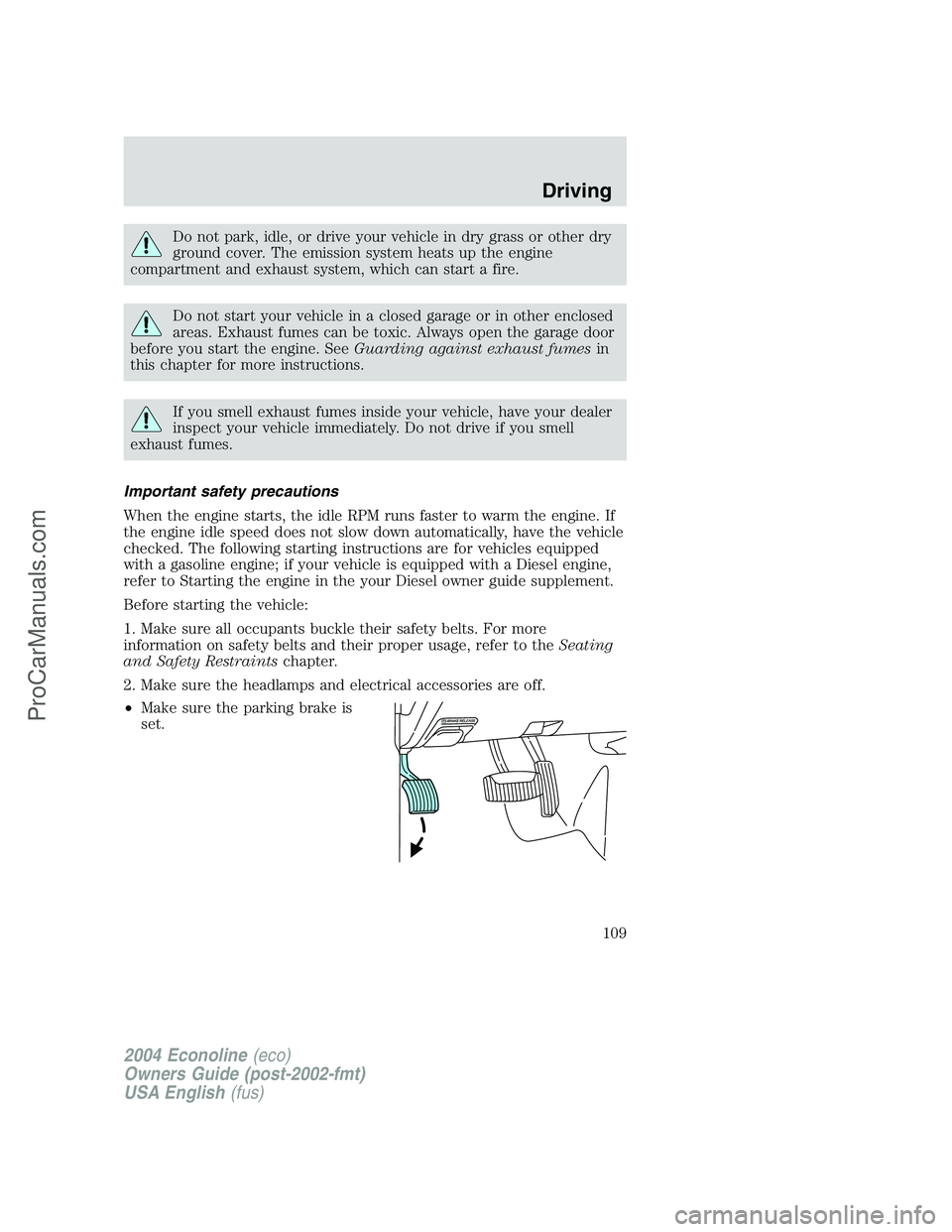
Do not park, idle, or drive your vehicle in dry grass or other dry
ground cover. The emission system heats up the engine
compartment and exhaust system, which can start a fire.
Do not start your vehicle in a closed garage or in other enclosed
areas. Exhaust fumes can be toxic. Always open the garage door
before you start the engine. SeeGuarding against exhaust fumesin
this chapter for more instructions.
If you smell exhaust fumes inside your vehicle, have your dealer
inspect your vehicle immediately. Do not drive if you smell
exhaust fumes.
Important safety precautions
When the engine starts, the idle RPM runs faster to warm the engine. If
the engine idle speed does not slow down automatically, have the vehicle
checked. The following starting instructions are for vehicles equipped
with a gasoline engine; if your vehicle is equipped with a Diesel engine,
refer to Starting the engine in the your Diesel owner guide supplement.
Before starting the vehicle:
1. Make sure all occupants buckle their safety belts. For more
information on safety belts and their proper usage, refer to theSeating
and Safety Restraintschapter.
2. Make sure the headlamps and electrical accessories are off.
•Make sure the parking brake is
set.
2004 Econoline(eco)
Owners Guide (post-2002-fmt)
USA English(fus)
Driving
109
ProCarManuals.com
Page 110 of 240
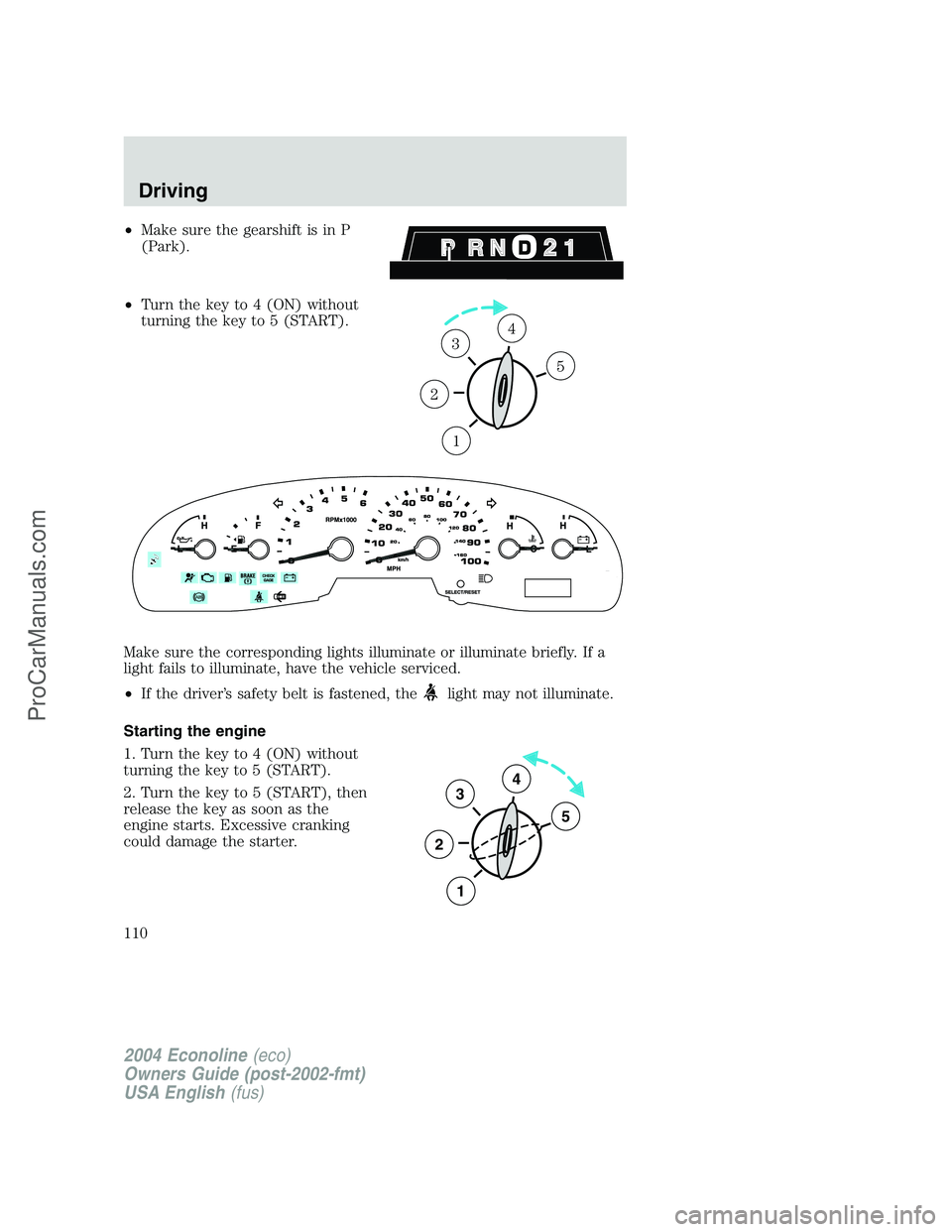
•Make sure the gearshift is in P
(Park).
•Turn the key to 4 (ON) without
turning the key to 5 (START).
Make sure the corresponding lights illuminate or illuminate briefly. If a
light fails to illuminate, have the vehicle serviced.
•If the driver’s safety belt is fastened, the
light may not illuminate.
Starting the engine
1. Turn the key to 4 (ON) without
turning the key to 5 (START).
2. Turn the key to 5 (START), then
release the key as soon as the
engine starts. Excessive cranking
could damage the starter.
1
2
34
5
3
2
1
5
4
2004 Econoline(eco)
Owners Guide (post-2002-fmt)
USA English(fus)
Driving
110
ProCarManuals.com